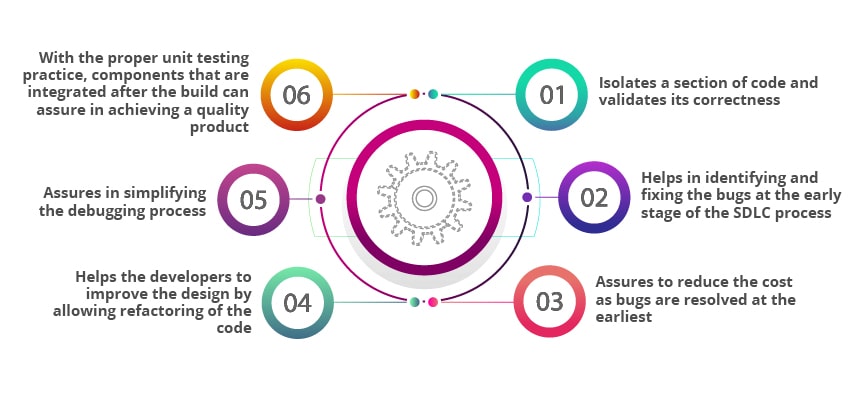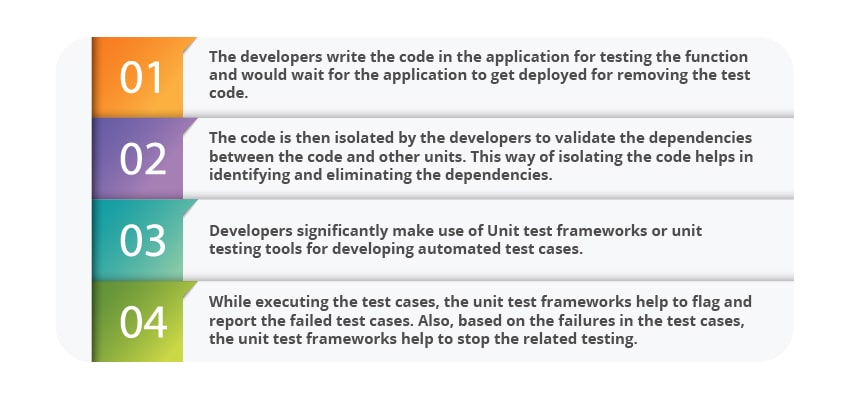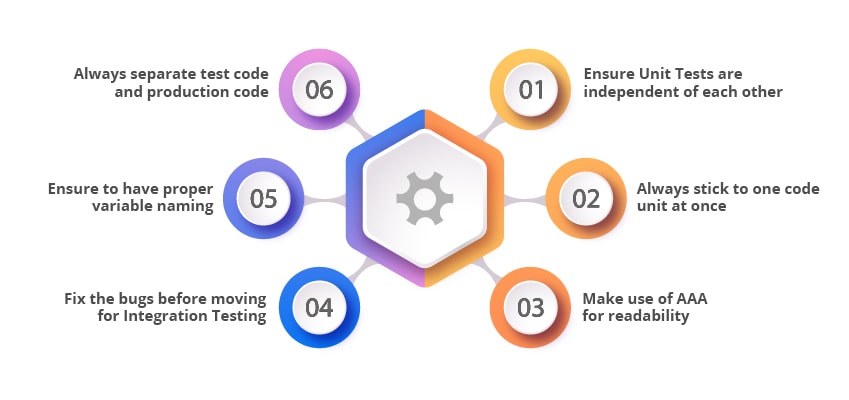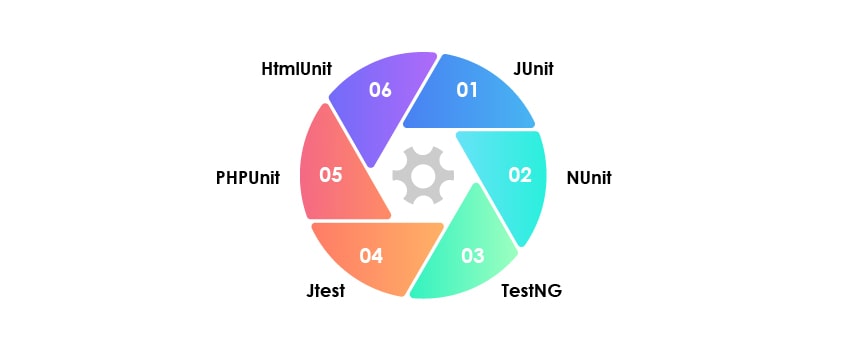
- What is Unit Testing?
- Why Unit Testing is important to perform?
- 5 Use Cases of AI in Wealth Management
- What are the types of Unit Testing?
- How to do Unit Testing?
- What are Unit Testing best practices?
- What are some important Unit Test frameworks?
- Unit Testing Vs Integration Testing
- Conclusion
What is Unit Testing?
Unit testing is one of the software testing types which includes the initial testing phase where the smallest components or the modules of a software are tested individually. With this method of testing, both testers and developers can isolate each module, identify and fix the system defects at a very early stage of the software development lifecycle (SDLC). Primarily, a unit test verifies different behavioral aspects of the system under test and can be broadly classified into state-based and interaction-based unit testing.

A typical unit test consists of three phases which include the first initialization phase where it initializes a small piece of an application it wants to test. The second phase is the addition phase where it adds a stimulus to the system under test and finally, the third phase is the result phase where it observes the resulting application behavior. Evidently, if the observed behavior is consistent with expectations, then the unit test passes else it fails. This indicates there is a problem somewhere in the system under test. These three test phases are named as Arrange, Act and Assert or commonly known as AAA.
Why Unit Testing is important to perform?

Unit Testing is the software testing technique where a group of software program components or modules are tested individually. This technique effectively helps in validating the accuracy of a section of code by considering stubs, mock objects, drivers, and unit testing frameworks. Since it is practiced at the initial testing phase, this testing technique assures to identify and fix the bugs at the early stage of SDLC even before they become expensive for the enterprises to fix when identified at a later stage.
Some developers may attempt to save time by performing minimal unit testing, or when unit testing is skipped, it obviously leads to higher defect fixing costs during system testing, integration testing, and even beta testing when the application is completed.
Moreover, in addition to these, unit testing helps the development teams to understand the code base, validate the correctness of the developed code, reuse the code, and to make the changes faster in the code.
With a proper unit testing practice in place, the developers and testers can help to save time as bugs can be identified early in the process as it is the initial phase of testing. And, skipping or limiting the practice of unit testing can adversely increase the defects and it becomes complex to fix them at a later stage. Hence, it is essential to practice unit testing at the initial stage of the oftware testing process before planning for the integration testing.
What are the benefits of Unit Testing?

– Helps in identifying and fixing the bugs at the early stage of the SDLC process
– Assures to reduce the cost as bugs are resolved at the earliest
– Helps the developers to improve the design by allowing refactoring of the code
– Assures in simplifying the debugging process
– With the proper unit testing practice, components that are integrated after the build can assure in achieving a quality product
What are the types of Unit Testing?

White Box Testing
This testing practice is also known as transparent testing or glass box testing. In this unit testing type, the functional behavior of the software is tested by the developers in order to validate their execution.
Black-box Testing
In this unit testing type, the unit testers are not aware of the internal functionality of the system and are allowed for testing the structure of the function, i.e. the user interface, input, and output.
Gray Box Testing
Gray box testing is popularly known for being the combination of both black-box and white-box testing. In this method, the tester is partially aware of the system functionality and uses this approach for testing various test methods, for executing test suites, and to perform the risk assessment. Also, this unit testing type is known as semi-transparent testing.
Who performs Unit Testing?
Unit testing is the first software testing phase in SDLC and it is usually taken up during the development of the application. These unit test cases are written and executed by software developers. However, in certain exceptional scenarios where developers take a back off to this process, this white-box testing technique is performed by QA engineers.
How to do Unit Testing?
Unit testing can be performed in two methods, i.e. by manual testing and automated testing.
In order to practice unit testing with the manual testing method, it is essential for the unit testers to get a step-by-step instructional document. However, considering the efforts needed for manual testing, automated unit testing is often preferred by most enterprises.
The workflow of unit testing is performed in 4 stages:
1. Creating test cases
2. Reviewing test cases
3. Baselining test cases
4. Executing test cases
Unit Testing process involves:

– The code is then isolated by the developers to validate the dependencies between the code and other units. This way of isolating the code helps in identifying and eliminating the dependencies.
– Developers significantly make use of Unit test frameworks or unit testing tools for developing automated test cases.
– While executing the test cases, the unit test frameworks help to flag and report the failed test cases. Also, based on the failures in the test cases, the unit test frameworks help to stop the related testing.
What are Unit Testing best practices?

1. Ensure Unit Tests are independent of each other:
While performing unit testing, make sure that all the unit tests are independent. If having any dependencies, then unit tests can get affected when there are any changes or enhancements. Also, it can result in complexities for the test cases to run and debug. Hence, always make sure that unit test cases are independent.
2. Always stick to one code unit at once:
When testing a unit of code, though it relates to multiple use cases, unit testers have to test each use case in different test cases. This will effectively simplify the teams to do code changes or refactoring.
3. Make use of AAA for readability:
AAA stands for Arrange, Act, and Assert. This pattern helps in separating what is being tested from the “arrange” and “assert” steps; thus reduces the inter-mix of the assertions with the help of the “Act”. Thus, the test cases are more readable.
4. Fix the bugs before moving for Integration Testing:
Unit testing is the first testing phase and it is practiced before moving to the phase of integration testing. Hence, before moving for the next testing level, make sure to fix all the identified bugs in the unit testing phase.
5. Ensure to have proper variable naming:
In unit testing, one of the important and best practices is to have proper naming of the variables. Therefore, avoid using magic strings, and also follow clear and consistent naming conventions.
6. Always separate test code and production code:
While performing unit testing, make sure that the test code is not deployed with the source code in your build script.
What are some important Unit Test frameworks?

JUnit:
This is an open-source unit testing framework that works effectively for test-driven development. It is explicitly designed to support Java language. This tool is well-known for providing an easy approach for writing code.
NUnit:
This unit testing framework is completely written in C# and this belongs to the xUnit family. It is an open-source tool and is capable of supporting all .NET languages and serves the same purpose as JUnit.
TestNG:
This is an open-source test automation framework exclusively developed for Java programming language. This framework specifically resembles Junit & NUnit and supports concurrent testing along with support for annotation.
Jtest:
This is an IDE plugin with effective open-source frameworks. The effective feature that can be achieved with this plugin is one-click action for creating, scaling, and maintaining unit tests.
PHPUnit:
This testing tool is designed to support PHP language. The beneficial feature of this tool is that it uses pre-defined assertion methods to make the system behave in a specific manner.
HtmlUnit:
This is an open-source unit testing framework to support JavaScript. It offers many great features for the teams such as open-source Java library, support for protocols, proxy servers, cookies, etc.
Unit Testing Vs Integration Testing

Integration testing is the second software testing phase conducted after unit testing. In Integration testing, the small modules that are individually tested in the unit testing are integrated or combined to test the functionality of the modules when they are together. However, to understand these two testing phases more easily, their major differences have been listed below.
| It is the initial testing phase in SDLC. | It is practiced after unit testing and before system testing. |
| In this testing practice, the smallest piece of the code is tested. | In this method, different modules are combined or integrated to test if they are working together. |
| Unit testing focuses on testing the functionality of the individual units | Integration testing focuses on identifying the bugs that are raised by integrating different modules. |
| Unit testing is a type of white-box testing. | Integration testing is a type of black-box testing. |
| It is performed by software developers or even by testers. | It is performed by testers. |
| Maintaining the unit test cases is cheaper. | Maintaining the integration test cases is expensive. |
| It is easy to find bugs in this method. | It is comparatively difficult for identifying issues in this method. |
| Unit testing is started with module specification. | Integration testing is started with interface specifications. |
Conclusion:
Businesses can be ensured of bug-free and quality software if software testing is performed effectively from the initial stage of product development. Software testing has to be taken up from the very first stage, i.e. from the code level itself; and this can be achieved when software developers perform the unit testing.
Unit testing is the earliest testing practice that focuses on the code. With this testing approach, small modules of the program are tested individually. This approach benefits the teams in many ways such as early bug detection, fixing the code before they become expensive to resolve in the SDLC. Hence, practicing unit testing is essential for businesses to ensure that the developed software is bug-free and quality is assured from the initial stage of SDLC. Leverage unit testing services from independent QA testing services provider to make your software get high-quality. Talk to us
Recommended Reading Blogs
1. Integration Testing: What is,Types, Tools, Steps to Perform
2. Automated Software Testing – What, Why, Tools, Challenges
3. UAT Testing Complete Guide
4. Mobile Testing Practices You Should Know
5. What is Agile Methodology?
6. Selenium testing Tutorials for Beginner’s
Related Queries on Unit Testing
Q1. What is the purpose of unit testing?
Ans. With a proper unit testing practice in place, the developers and testers can help to save time as bugs can be identified early in the process as it is the initial phase of testing.
Q2. When Should unit testing be performed?
Ans. It is essential to practice unit testing at the initial stage of the software testing process before planning for the integration testing.
Q3. Who performs Unit Testing?
Ans. These unit test cases are written and executed by software developers
Q4. What are unit testing frameworks?
Ans. Some important Unit Test frameworks are listed here.
Categories

Stay Updated
Subscribe for more info













